|
header
|
 |
|
MENU
|
|
 |
DONGYANG WOOD CARVING
28/08 ~ 09/09This school of woodcarving, named
after Dongyang, can trace its history back 1,000 years, and numerous treasures
of this art have been accumulated there. Its themes revolve around historical,
mythical and legendary figures, and bas-relief is its primary technique. Works
are characterised by ancient and elegant simplicity. In keeping with the times,
it has shifted its emphasis from building decor to modern architecture and
furniture, for which it is widely renowned, as well as works of art.
Chen Yizhong has been in the trade
for more than 10 years, and has received several national and provincial awards
for his creations. He works as chief designer in the woodcarving studio he
established in 2006.
|
| |
|
 |
DONGYANG BAMBOO WEAVING
28/08 ~ 09/09
Dongyang bamboo
weaving may indeed be seen as an artistic sister of
Dongyang woodcarving. In the Song Dynasty, it was
famed for its lanterns, produced for the Lantern Festival. In the
Ming and Qing dynasties, it was a renowned source of gifts
for the imperial family. It is at its best in cubic
weaving and in unique and lifelike shapes,
characterised by clean, light colouring.
He Fuli is famed
as a ‘master of Chinese bamboo craft’, and many of his
works have won national awards. The ‘Dragon of Craft’,
made especially for the Hong Kong Handover in 1997, measures
2,500 metres in length – a world record for an object of its
kind.
|
| |
|
 |
FANHUANG
BAMBOO GARVING
11/09 ~ 23/09
Fanhuang bamboo
carving, a traditional native craft of Huangyan in Zhejiang, is called Fanhuang
in Chinese because the carving is done on the inner lining of a bamboo stem. The
art originated in the 9th year of the Tongzhi Era of the Qing
Dynasty, and has evolved over a hundred years or so. Employing primarily the
technique of relief engraving, these carvings appear lustrous as if made of
ivory. This craft – together with Qingtian stone carving and Dongyang-Huangyang
woodcarving – is one of the ‘Three Carvings of Zhejiang’.
Now 19 years of
age, Lu Zhixian is an accomplished carver and expert in fashioning Fanhuang
bamboo. He is employed as the head of the Fanhuang Bamboo Carving Studio in
Huangyan and is regarded as one of the most foremost proponents of the art.
|
| |
|
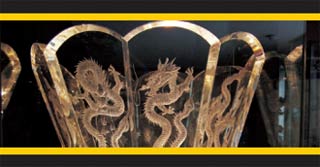 |
GLASS ENGRAVING
11/09 ~ 23/09
Glass engraving
is a unique art in which sanding wheels are used like
a pen or brush to paint on glass. Landscapes, flora and
fauna and human figures are etched into glass in such a way
that they look as if they lived in it.
Son of a famed
glass engraving artist, Wu Gang has acquired his
father’s artistry and is now Director of the Glass Carving Gallery
in Taizhou, named after his father Wu Zixiong. The crystal
carving ‘Dancing Lions in a Lotus Setting’ was one of
the important gifts bestowed on Macao to celebrate the
territory’s handover.
|
| |
|
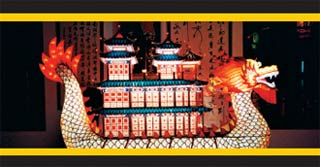 |
XIASHI LANTERNS
01/10
~ 14/10
Originating from
Xiashi Town in Haining City, Zhejiang Province, Xiashi lanterns are an art genre
that dates back more than 1,200 years. The lanterns were used as gifts for the
Imperial Court in the Southern Song Dynasty and are famed for their stitched
patterns. Xuan paper, bamboo strips and iron wire are all used in the creation
of these beautiful adornments. Paintings on the lanterns are illuminated from
the inside, and with the use of modern audio, lighting and electrical devices,
many imaginative and uniquely-shaped lanterns are currently produced.
Hu Jinlong now
serves as Deputy President of the Xiashi Lantern Society and is CEO of Xiashi
Lantern Co. Ltd. in Haining. His professional experience encompasses more than
20 years of work, and he is the recipient of numerous honorary awards.
|
| |
|
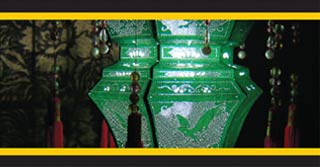 |
EMBROIDERED FRAMELESS LANTERNS
01/10
~ 14/10
Originating in
the Tang Dynasty, embroidered frameless
lanterns made in Xianju County in Zhejiang Province are also
known as Tang lanterns or Sheng lanterns. The
frameless lanterns are made
from pieces of paper embroidered with various patterns.
Their construction requires painting and embroidery
expertise as well as other
skills. The art is constantly evolving and is considered
the pinnacle of traditional women’s craft.
Li Xiangman is
the Director of the Research Institute for
Embroidered Frameless Lanterns in Xianju County and has been
nominated one of the ‘10 Best Artisans in China’. His
‘Lantern of Phoenix and Dragon’
was represented on a special postage stamp
by the State Postal Bureau in 2005 and was included on the
First Selection of National
Intangible Cultural Heritage List in 2006.
|
| |
|
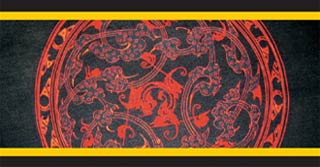 |
HANGZHOU
EMBROIDERY
16/10 ~ 28/10
Hangzhou has long
been known as the City of Silk. Its flourishing silk industry gave rise to its
embroidery arts, which reached their zenith during the Southern Song Dynasty.
Hangzhou embroidery encompasses many forms of refined craftsmanship,
incorporating numerous features of these arts. It takes as its themes such
popular icons as dragons, phoenixes, peonies and scenes of the West Lake, most
of which are traditional images.
Yu Zhiyin is the
Secretary General of the Hangzhou Arts and Crafts Academy and is a Master
Artisan of Zhejiang. Her works emanate a strong sense of humanity, affinity with
nature, peace and intimacy.
|
| |
|
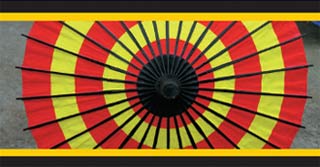 |
XIHU SILK UMBRELLAS
16/10 ~ 28/10
Hangzhou’s famous
umbrella-making craft dates back to ancient times. Known as the ‘Flowers of the
West Lake’, Xihu silk umbrellas employ bamboo frames and locally produced silk
cloth. They are generally light, brightly coloured and decorated with paintings
of landscapes and flora and fauna, which echo classical life in the regions to
the south of the Yangtze River. These objects are popular with the masses and
the cultivated alike.
Wen Dehan has
worked in the trade for nearly 20 years and is currently the Director of the
Xinyi Arts and Crafts Umbrella Factory in Fuyang City. His ‘The Way of the Tea
Umbrella’ was awarded a gold medal for being one of the best creations ever
produced by a Hangzhou artist.
|
| |
|
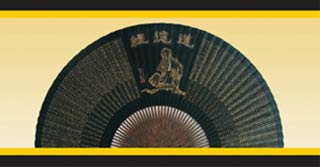 |
HANGZHOU FANS
31/10 ~ 11/11
Hangzhou fans are
time-honoured treasures, superior in quality and rich in diversity, with myriad
ornamentations. Fans made by Wangxing Fan Co. (established 1875) are the best in
the trade, never fading even after long exposure to sunlight. Particularly
famous is the ‘Black Paper Fan’, recognised for its excellent waterproof
quality. These are useful as well as artistic objects and were once presented as
gifts for the imperial family. These days, Hangzhou fans are widely known as one
of ‘Hangzhou’s Best’ products, along with Hangzhou silk and Longjing tea.
Zhao Pingjia, a
renowned expert on the specialised calligraphy and painting done on fans and a
designer at the Wangxing Fan Co. with 30 years of career experience, has toured
overseas several times to demonstrate the making of fans. Zhao has created some
3,000 works, many of which have been honoured.
|
| |
|
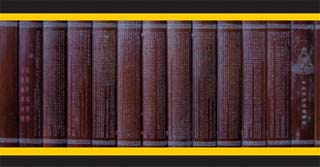 |
MICRO-ENGRAVING
13/11 ~ 25/11
Micro-engraving in China can be
traced back 3,000 years to the Yin and the Shang dynasties and is generally
divided into three categories: stone, hair and grain engravings. As a
prerequisite, the artisan must have unrivaled eyesight and the complete command
of his hands, requirements so demanding that experts in this trade are few and
far between.
Feng Yaozhong is one of the best and
can work on items as small as a sesame seed or a strand of hair. Feng is
acknowledged as one of the Master Artisans of Zhejiang and is the Chairman of
the Preparatory Committee for the China Micro-engraving Society. Many of his
works have been listed in the Guinness Book of World Records.
|
| |
|
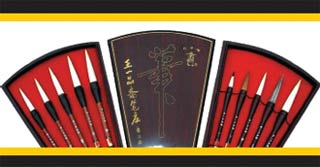 |
HUZHOU WRITING BRUSHES
13/11 ~ 25/11
The making of
Huzhou writing brushes reached its pinnacle in the
Yuan Dynasty, and even today these brushes are considered
among the best of their kind in China. The art originated in
Shanlian Town in Huzhou City, Zhejiang Province. Their
production embraces some 120 processes, and the
selection of materials used, such as goat hair, is
painstaking. The ‘pointedness’ of the hair, the
uniformity of its line, its full abundance and elasticity, are all
critically important elements of the finished product.
Zhu Yaqin comes
from a family with many generations of brush making
specialists and has over 30 years of experience in the
art. Zhu is Chief of the Brush Making Section of the Wang Yipin
Stationery Factory and is a member of the Huzhou Writing
Brush Making Society.
|
| |
|
BACK
|
|

|
|